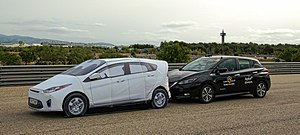automatic emergency braking
nujno avtomatsko zaviranje
This article contains content that is written like an advertisement. (March 2017) (Learn how and when to remove this template message) |

A collision avoidance system (CAS), also known as a pre-crash system, forward collision warning system, or collision mitigation system, is an automobile safety system designed to prevent or reduce the severity of a collision. In its basic form, a forward collision warning system monitors a vehicle's speed, the speed of the vehicle in front of it, and the distance between the vehicles, so that it can provide a warning to the driver if the vehicles get too close, potentially helping to avoid a crash. Various technologies and sensors that are used include radar (all-weather) and sometimes laser (LIDAR) and camera (employing image recognition) to detect an imminent crash. GPS sensors can detect fixed dangers such as approaching stop signs through a location database. Pedestrian detection can also be a feature of these types of systems.
Collision avoidance system range from widespread systems mandatory in some countries, such as Autonomous Emergency Braking (AEB) in the EU, agreements between automakers and safety officials to make crash avoidance systems eventually standard, such as in the United States, to research projects including some manufacturer specific devices.
Advanced emergency braking system (AEBS) as defined by UN ECE regulation 131 is considered as: a system which can automatically detect a potential forward collision and activate the vehicle braking system to decelerate the vehicle with the purpose of avoiding or mitigating a collision. UN ECE regulation 152 says deceleration can be 5 meter per square second.
Once an impending collision is detected, these systems provide a warning to the driver. When the collision becomes imminent, they can take action autonomously without any driver input (by braking or steering or both). Collision avoidance by braking is appropriate at low vehicle speeds (e.g. below 50 km/h (31 mph)), while collision avoidance by steering may be more appropriate at higher vehicle speeds if lanes are clear. Cars with collision avoidance may also be equipped with Adaptive Cruise Control, using the same forward-looking sensors.
AEB differs from Forward Collision Warning: FCW alert the driver with a warning but does not by itself brake the vehicle.
According to Euro NCAP, AEB has three characteristics:
- Autonomous: the system acts independently of the driver to avoid or mitigate the accident.
- Emergency: the system will intervene only in a critical situation.
- Braking: the system tries to avoid the accident by applying the brakes.
Time-to-collision could be a way to choose which avoidance method (braking or steering) is best appropriate.
Collision avoidance system by steering is a new concept. It is considered by some research projects. Collision avoidance system by steering has some limitations: over-dependence on lane markings, sensor limitations, and interaction between driver and system.



